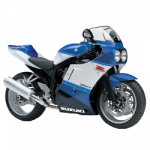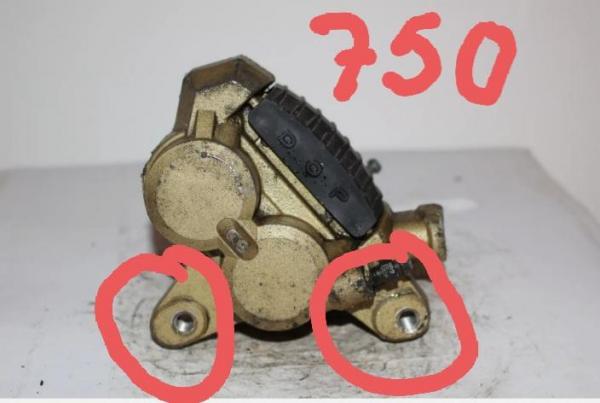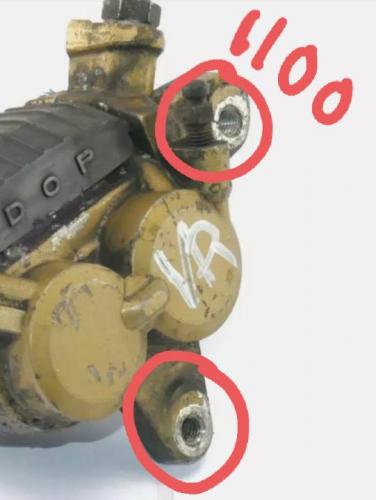-
Posts
123 -
Joined
-
Last visited
Content Type
Profiles
Forums
Events
Everything posted by Nik
-
It's there to dissipate heat to the oil, not to the other valve areas.
-
It's a cooling device to help dissipate heat from the exhaust valve area.
-
Of course! Meant DOT vs 1100/1200. Corrected my post.
-
DOT heads were used on the 88-89 GSX-R 750 and on the 89-97 GSX-F/Teapots. The DOT heads have steeper inlets, appr. 15 mm higher than the 1100/1200 heads. The valve diameters are the same as on the 1100/1200. Combustion chambers are appr. 20 cc, compared to 26.5 cc on the 1100/1200. Cams were different between the R and F.
-
1985-87 GSX-R 750 ran Mikuni VM29 carbs (except a few countries, incl. the U.S.). They were designed as 33 mm, which was considered too big for the 750, so Mikuni made new castings for the body housing part facing the filters. Therfore, the filter side is 29 mm, while the head side is 33 mm. You could run your 1127 with them, as is, but you would lose quite a lot of top end power. However, it is easy to remove the 29 mm housing part, and any decent machine shop could enlarge it in a mill to 33 mm easily. Then you'll have some very nice carbs for the 1127. Not as much top end power as if you have RS36/38, but very smooth and nice. I had 33s on an earlier bike (7/11 with 1127 F), and it ran wonderfully.
-
I made my first 6-speed 7/11 in 1991. At the time, little was known about exchangeability between years etc. I simply took my 1985 750 6-speed gearbox and put it in my 1127. The splines for the clutch basket were different, so I had the shaft's splines reworked (CNC spark erosion machine) to fit the 1127 clutch. Easy! Ive ridden it 140,000 km since then, hard, without any problems. Later, I did other 6-speed 1127s by using post-87 750 6-speed gearboxes (same splines as 1100). Since the later main shafts aren't drilled (for the clutch push rod, from the left-side slave cylinder), I used the J/K 750 wire solution. No machining needed, and you get a better feeling from a wire clutch. I have built four 7/11 with 6-speeds (two more on the way), and I've never had any problems. I keep hearing "my friend did this", "I heard that ... " or "why do it, you don't need it on an 1100". The fact is that it makes a big difference. For me, and most who has actually tried it. Concerning strength and reliability of a 6-speed; yes, the gears are slightly narrower, but I have never seen a street gearbox break because of that. It's the dogs that wear and break (and there are more dogs on the 6-speed gears, even if they're smaller). I've replaced more 2nd gears on my 5-speed 1100s than on my 6-speeds. Of course, you don't put a 6-speed in a proper race engine, but I would't hesitate to do it on a 140 hp engine. My two cents ...
-
What's your rider sag? Note that preload doesn't change the stiffness, but only raises or lowers the rear (unleas you put on excessive preload so all rider sag is gone).
-
Have you connected the oil cooler in parallel with the cam lubrication?
-
Just to avoid misunderstandings, J is 1988 (slingshot).
-
That would be the first 1127 cc engine. 1100F from 1988.
-
That J-Tech site's spring calculator is generic. The one on Race Tech's site is model specific. For a slabby 1100 and your weight, they recommend 100 N/mm. Older Japanese bikes are typically designed for a 70 kg driver, and for a full-grown man, I'd say that 75 N/mm is too soft.
-
As you see on the photos, the 1100 calipers are drilled so the calipers sit considerably higher on the fork leg.
-
The caliper body castings are the same, but the 1100s had larger discs, and the threaded holes in the calipers were placed differently on 750s vs 1100s.
-
My guess would be piston slap. How much was the piston to cylinder clearance when it was assembled?
-
I can't remember that the carbs are sigificantly more angled on a DOT head, only that the inlets are placed appr. 15 mm higher than other heads. I have a bunch, but I am not sure where (too many garages ... ). I'll see if I can find some and take some photos and measurements.
-
The DOT heads have higher inlet ports (appr. 15 mm). Chamber volume and valves are the same.
-
OP; you have a 2-piece seat (they were used in 1985, maybe early 86), and you should use a cowl that replaces the rear half of the seat. Later models used a 1-piece seat, and used the kind of cowl shown on Clive''s photo above. Cheaper to manufacture for sure, but less good-looking IMHO. https://www.cmsnl.com/suzuki-gsxr750-1985-f-e01-2-4-6-15-16-17-18-21-22-24-25-34-39-53_model13570/partslist/FIG-40.html#.Xv4zyWm5mdM
-
Great, Clive! Thanks! So the conclusion is that out of the tanks you have, there are two sizes (not counting the minuscule volume of the raised filler edge)?
-
I understand that it's difficult to measure, but it should be pretty straight-forward to measure the height and width at the center of the filler cap. If those measurements are similar, I guess the tanks are the same shape.
-
Sorry to bother you Clive, but isn't that just an illusion? This is very interesting, and since you have the tanks available for side-by-side comparisons, it would be great to compare the actual measurements, not just the visual impression. Just to clarify, I am talking about the black/gold vs the white/blue tanks, and I presume you don't count the fake endurance filller edge protrusion as an added volume in itself. If you actually measure them, are they different? I have tried to gather facts on the various tank variants for many years, and I'd also like to ask; does anybody here know what was different with the E22 (West Germany) tank?
-
Great! What's the difference in measurements/volume between the black/gold and blue/white?
-
3 sizes!? Was there ever a smaller tank than the 85 (on some markets in 86 too) flat tank?
-
OP; the tank on the photo is the larger model. Smaller/flatter tanks were used on all 1985 750s, some (most?) markets' 1986 750s, some markets' 1986 1100s.
-
Yes, slabby. Identified by the fine splines on the clutch side. Later shafts had coarser splines. Note that you will not find an 1100/1200 clutch basket that fits the fine splines. I put a similar box in my first 7/11 (powerscreen engine in slabby). At the time, 1100 engines were scarse, and little was known about which models had what shafts/splines, so I had a tool shop reshape the fine-splined shaft with coarser splines (by spark erosion, the tool shop where I work). I have run it since 1991 and it works fine, but I guess it would cost a fortune today and it's easier and better to use a later shaft with the coarser splines to begin with.





